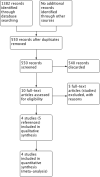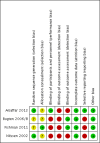Sinonasal debridement versus no debridement for the postoperative care of patients undergoing endoscopic sinus surgery
- PMID: 30407624
- PMCID: PMC6517168
- DOI: 10.1002/14651858.CD011988.pub2
Sinonasal debridement versus no debridement for the postoperative care of patients undergoing endoscopic sinus surgery
Abstract
Background: Endoscopic sinus surgery (ESS) is often recommended for symptomatic patients with recurrent acute or chronic rhinosinusitis who have failed conservative treatment. Postoperative care has been felt to be critical for both maintaining the surgical patency of the operated sinuses and improving patient symptoms. Debridement of the sinonasal cavities is one such postoperative care measure that has frequently been studied in the literature, often with conflicting conclusions.
Objectives: To assess the effects of postoperative sinonasal debridement versus no debridement following endoscopic sinus surgery.
Search methods: The Cochrane ENT Information Specialist searched the ENT Trials Register; Central Register of Controlled Trials (CENTRAL, via the Cochrane Register of Studies); PubMed; EMBASE; Web of Science; ClinicalTrials.gov; ICTRP and additional sources for published and unpublished trials. The date of the search was 21 May 2018.
Selection criteria: Randomised controlled trials comparing postoperative nasal debridement versus no debridement in adult patients with recurrent acute or chronic rhinosinusitis undergoing endoscopic sinus surgery. We included studies in which the patients acted as self-controls (i.e. one side of the nose underwent debridement and the other side did not) only for the secondary endoscopy outcomes.
Data collection and analysis: We used the standard methodological procedures expected by Cochrane. Our primary outcome measures were: health-related quality of life, disease severity (patient-reported symptom scores) and significant adverse effects (bleeding requiring intervention, severe pain, iatrogenic injury). Secondary outcomes were: postoperative endoscopic appearance of the sinonasal surgical cavities (endoscopic scores), recorded use of postoperative medical treatment and rate of revision surgery. We used GRADE to assess the quality of the evidence for each outcome; this is indicated in italics.
Main results: We included four studies (152 participants), with a follow-up duration ranging from three months to 12 months. In two studies patients acted as self-controls, i.e. one side of the nose underwent debridement and the other side did not ('split-nose' studies). The risk of bias in all studies was high, mostly due to the inability to blind the patients to the debridement procedure.Primary outcomesDisease-specific health-related quality of life scoresOnly one study (58 participants) provided data for disease-specific health-related quality of life. At six months follow-up, lower disease-specific health-related quality of life scores, measured using the Sino-Nasal Outcome Test-22 (SNOT-22, range 0 to 110), were noted in the debridement group but the difference was not statistically significant (9.7 in the debridement group versus 10.3 in the control group, P = 0.47) (low-quality evidence).Disease severity (patient-reported symptom score)Only one study (60 participants) provided data for disease severity measured by visual analogue scale (VAS) score. No significant differences in total symptom score were observed between groups postoperatively (low-quality evidence).Significant adverse effectsSignificant adverse effects related to the debridement procedure were not reported in any of the included studies, however it is not clear whether data regarding adverse effects were not collected or if none were indeed observed in any of the included studies.Secondary outcomesAll four studies assessed thepostoperative endoscopic appearance of the sinonasal cavities using the Lund-Kennedy score (range 0 to 10). A pooled analysis of endoscopic scores in the two non 'split-nose' studies revealed better endoscopic scores in the debridement group, however this was not a statistically significant difference (mean difference -0.31, 95% confidence interval (CI) -1.35 to 0.72; I² = 0%; two studies; 118 participants) (low-quality evidence). A sub-analysis of the adhesion formation component of the endoscopic score was available for all four studies and revealed a significantly lower adhesion rate in the debridement group (risk ratio 0.43, 95% CI 0.28 to 0.68; I² = 29%; four studies; 152 participants). Analysis of the number needed to treat to benefit revealed that for every three patients undergoing debridement, the endoscopic score would be decreased by one point in one patient. For every five patients undergoing debridement adhesion formation would be prevented in one patient.Use of postoperative medical treatment was reported in all studies, all of which recommended nasal douching. Steroids (systemic or nasal) were administered in two studies. However, the data were very limited and heterogeneous, therefore we could not analyse the impact of concomitant postoperative medical treatment.The rate of revision surgery was not reported in any of the included studies, however it is not clear whether these data were not recorded or if there were no revision surgeries in any of the included studies.
Authors' conclusions: We are uncertain about the effects of postoperative sinonasal debridement due to high risk of bias in the included studies and the low quality of the evidence. Sinonasal debridement may make little or no difference to disease-specific health-related quality of life or disease severity. Low-quality evidence suggests that postoperative debridement is associated with a significantly lower risk of adhesions at three months follow-up. Whether this has any impact on longer-term outcomes is unknown.
Conflict of interest statement
Ethan Soudry: none known.
Tzelnick Sharon: none known.
Alkan Uri: none known.
Peter Hwang: consultancy for Intersect ENT, Medtronic and Sinuwave. Consultancies are unrelated to the subject matter of the manuscript.
Moshe Leshno: none known.
Figures





Update of
- doi: 10.1002/14651858.CD011988
Similar articles
-
Biologics for chronic rhinosinusitis.Cochrane Database Syst Rev. 2020 Feb 27;2(2):CD013513. doi: 10.1002/14651858.CD013513.pub2. Cochrane Database Syst Rev. 2020. Update in: Cochrane Database Syst Rev. 2021 Mar 12;3:CD013513. doi: 10.1002/14651858.CD013513.pub3. PMID: 32102112 Free PMC article. Updated.
-
Biologics for chronic rhinosinusitis.Cochrane Database Syst Rev. 2021 Mar 12;3(3):CD013513. doi: 10.1002/14651858.CD013513.pub3. Cochrane Database Syst Rev. 2021. PMID: 33710614 Free PMC article.
-
Tranexamic acid for the reduction of bleeding during functional endoscopic sinus surgery.Cochrane Database Syst Rev. 2023 Feb 21;2(2):CD012843. doi: 10.1002/14651858.CD012843.pub2. Cochrane Database Syst Rev. 2023. PMID: 36808096 Free PMC article. Review.
-
Utility of Second-Look Endoscopy with Debridement After Pediatric Functional Endoscopic Sinus Surgery in Patients with Cystic Fibrosis.Ann Otol Rhinol Laryngol. 2020 Dec;129(12):1153-1162. doi: 10.1177/0003489420922865. Epub 2020 Jun 9. Ann Otol Rhinol Laryngol. 2020. PMID: 32517494
-
Indications and Outcomes for Patients With Limited Symptoms Undergoing Endoscopic Sinus Surgery.Am J Rhinol Allergy. 2020 Jul;34(4):502-507. doi: 10.1177/1945892420912159. Epub 2020 Mar 13. Am J Rhinol Allergy. 2020. PMID: 32168996
Cited by
-
Perioperative management of endoscopic transsphenoidal pituitary surgery.World J Otorhinolaryngol Head Neck Surg. 2020 Mar 20;6(2):84-93. doi: 10.1016/j.wjorl.2020.01.005. eCollection 2020 Jun. World J Otorhinolaryngol Head Neck Surg. 2020. PMID: 32596652 Free PMC article. Review.
-
Rhinosinusitis: Evidence and experience - 2024.Braz J Otorhinolaryngol. 2025 May 19;91(5):101595. doi: 10.1016/j.bjorl.2025.101595. Online ahead of print. Braz J Otorhinolaryngol. 2025. PMID: 40398368 Free PMC article.
-
Trends in Endoscopic Sinonasal Debridement in the Medicare Population.Perm J. 2021 May;25:20.110. doi: 10.7812/TPP/20.110. Perm J. 2021. PMID: 33970073 Free PMC article.
-
Variation in Postoperative Debridement Patterns in Endoscopic Sinus Surgery: A Retrospective Cohort Study.Int Forum Allergy Rhinol. 2025 May;15(5):543-546. doi: 10.1002/alr.23515. Epub 2025 Jan 8. Int Forum Allergy Rhinol. 2025. PMID: 39777891 Free PMC article. No abstract available.
-
Anterior Pedicled Nasal Flap in Frontal Sinus Drill-Out Patients: A Randomised Controlled Pilot Study.J Clin Med. 2022 Jul 26;11(15):4329. doi: 10.3390/jcm11154329. J Clin Med. 2022. PMID: 35893422 Free PMC article.
References
References to studies included in this review
Alsaffar 2013 {published data only}
-
- Alsaffar H, Sowerby L, Rotenberg BW. Postoperative nasal debridement after endoscopic sinus surgery: a randomized controlled trial. Annals of Otology, Rhinology, and Laryngology 2013;122(10):642‐7. - PubMed
Bugten 2006/8 {published data only}
-
- Bugten V, Nordgård S, Steinsvåg S. Long‐term effects of postoperative measures after sinus surgery. European Archives of Oto‐rhino‐laryngology 2008;265(5):531‐7. - PubMed
-
- Bugten V, Nordgård S, Steinsvåg S. The effects of debridement after endoscopic sinus surgery. Laryngoscope 2006;116(11):2037‐43. - PubMed
Fishman 2011 {published data only}
-
- Fishman JM, Sood S, Chaudhari M, Martinez‐Devesa P, Orr L, Gupta D. Prospective, randomised controlled trial comparing intense endoscopic cleaning versus minimal intervention in the early post‐operative period following functional endoscopic sinus surgery. Journal of Laryngology and Otology 2011;125(6):585‐9. - PubMed
Nilssen 2002 {published data only}
-
- Nilssen EL, Wardrop P, El‐Hakim H, White PS, Gardiner Q, Ogston S. A randomized control trial of post‐operative care following endoscopic sinus surgery: debridement versus no debridement. Journal of Laryngology and Otology 2002;116(2):108‐11. - PubMed
References to studies excluded from this review
Green 2015 {published data only}
-
- Green R, Banigo A, Hathorn I. Postoperative nasal debridement following functional endoscopic sinus surgery, a systematic review of the literature. Clinical Otolaryngology 2015;40(1):2‐8. - PubMed
Lee 2008 {published data only}
-
- Lee JY, Byun JY. Relationship between the frequency of postoperative debridement and patient discomfort, healing period, surgical outcomes, and compliance after endoscopic sinus surgery. Laryngoscope 2008;118(10):1868‐72. - PubMed
Rudmik 2011 {published data only}
-
- Rudmik L, Soler ZM, Orlandi RR, Stewart MG, Bhattacharyya N, Kennedy DW, et al. Early postoperative care following endoscopic sinus surgery: an evidence‐based review with recommendations. International Forum of Allergy & Rhinology 2011;1(6):417‐30. - PubMed
Shi 2015 {published data only}
Varsak 2015 {published data only}
-
- Varsak YK, Yuca K, Eryılmaz MA, Arbag H. Single seventh day debridement compared to frequent debridement after endoscopic sinus surgery: a randomized controlled trial. European Archives of Oto‐rhino‐laryngology 2016;273(3):689‐95. - PubMed
Additional references
Albu 2010
-
- Albu S, Lucaciu R. Prophylactic antibiotics in endoscopic sinus surgery: a short follow‐up study. American Journal of Rhinology & Allergy 2010;24(4):306‐9. - PubMed
Annys 2000
-
- Annys E, Jorissen M. Short term effects of antibiotics (Zinnat) after endoscopic sinus surgery. Acta Oto‐Rhino‐Laryngologica Belgica 2000;54:23‐8. - PubMed
Bassiouni 2015
-
- Bassiouni A, Chen PG, Naidoo Y, Wormald PJ. Clinical significance of middle turbinate lateralization after endoscopic sinus surgery. Laryngoscope 2015;125(1):36‐41. - PubMed
Bhattacharyya 2009
-
- Bhattacharyya N. Contemporary assessment of the disease burden of sinusitis. American Journal of Rhinology & Allergy 2009;23:392‐5. - PubMed
Blackwell 2014
-
- Blackwell DL, Lucas JW, Clarke TC. Summary health statistics for U.S. adults: national health interview survey, 2012. Vital Health Statistics 10 2014;260:1‐161. - PubMed
Bugten 2006
-
- Bugten V, Nordgård S, Steinsvåg S. The effects of debridement after endoscopic sinus surgery. Laryngoscope 2006;116(11):2037‐43. - PubMed
Dautremont 2014
-
- Dautremont JF, Mechor B, Rudmik L. The role of immediate postoperative systemic corticosteroids when utilizing a steroid‐eluting spacer following sinus surgery. Otolaryngology ‐ Head and Neck Surgery 2014;150(4):689‐95. - PubMed
DelGaudio 2006
-
- DelGaudio JM, Wise SK. Topical steroid drops for the treatment of sinus ostia stenosis in the postoperative period. American Journal of Rhinology 2006;50:563‐7. - PubMed
Handbook 2011
-
- Higgins JPT, Green S (editors). Cochrane Handbook for Systematic Reviews of Interventions Version 5.1.0 [updated March 2011]. The Cochrane Collaboration, 2011. Available from www.cochrane‐handbook.org.
Henriquez 2013
Huang 2015
Jiang 2008
-
- Jiang RS, Liang KL, Yang KY. Postoperative antibiotic care after functional endoscopic sinus surgery. American Journal of Rhinology 2008;22:608‐12. - PubMed
Jorissen 2004
-
- Jorissen M. Postoperative care following endoscopic sinus surgery. Rhinology 2004;42(3):114‐20. - PubMed
Kemppainen 2008
-
- Kemppainen T, Seppä J, Tuomilehto H, Kokki H, Nuutinen J. Repeated early debridement does not provide significant symptomatic benefit after ESS. Rhinology 2008;46(3):238‐42. - PubMed
Low 2014
-
- Low TH, Woods CM, Ullah S, Carney AS. A double‐blind randomized controlled trial of normal saline, lactated Ringer's, and hypertonic saline nasal irrigation solution after endoscopic sinus surgery. American Journal of Rhinology & Allergy 2014;28(3):225‐31. - PubMed
Portela 2012
-
- Portela RA, Hootnick J, McGinn J. Perioperative care in functional endoscopic sinus surgery: a survey study. International Forum of Allergy & Rhinology 2012;2(1):27‐33. - PubMed
RevMan 2014 [Computer program]
-
- The Nordic Cochrane Centre, The Cochrane Collaboration. Review Manager (RevMan). Version 5.3. Copenhagen: The Nordic Cochrane Centre, The Cochrane Collaboration, 2014.
References to other published versions of this review
Publication types
MeSH terms
LinkOut - more resources
Full Text Sources
Medical
Research Materials
Miscellaneous

